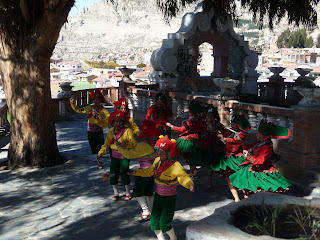Our two-and-a-half-month-long stay in Bolivia came to an end soon after we had departed from Copacabana. We didn't spend much time at the border: this was the first time in South America when my Estonian passport was not subjected to extreme scrutiny. In fact, the lady working at the Peruvian border was on the phone while stamping the passports and didn't seem to be too bothered by us. Thus, we said good-bye to Bolivia and hello to Peru!
A couple of hours later, we arrived in Puno, which is located at Lake Titicaca, similarly to Copacabana. The first thing we noticed was the taxi driver putting on his seat belt. The only time we saw people using their seat belts in Bolivia was when our friends Cynthia and Gonzalo drove us around in Santa Cruz. Since that taxi ride, though, we've often seen the Peruvian drivers put on their seat belt only when they've spotted police officers.
Still recovering from stomach problems, we took the first couple of days in Peru very easy. We wanted to visit the nearby islands, and decided to go on a two-day tour with
All Ways Travel, and were especially looking forward to meeting a Peruvian family through homestay on Amantani island.
The trip involved several sunny and nice boat rides on Lake Titicaca. On the first day, we visited the floating Uros islands. For the past several hundred years, the Uru people have created their own islands out of reeds, and they continue to do so nowadays. They use reeds for just about everything else as well: to build houses and boats; they even eat these plants. A lady named Olga showed us her house and asked us to dress up in the local clothes. Afterwards, she and her family started to pressure us to buy souvenirs, and we felt rather uncomfortable. This was the first time that we sensed that Peru is far more touristy than Bolivia, perhaps even too touristy.
 |
| One of the more than 40 floating reed islands, with reed houses and reed boats |
 |
| Together with Olga on a floating island |
We then went to Amantani, the largest island on the Peruvian side of Lake Titicaca. Here, our group was split up, so that up to four people would stay with individual families of the island. Radek and I were teamed up with an Italian couple - Simone and Stefania. While our host lead us to his house, we had a chance to talk to him a bit. Sadly, this turned out to be the only time we would talk with him - the family practically ignored us during our stay, and their home was much rather like a basic hotel. All four of us were very disappointed, because we had really wanted to meet a local family. Fortunately, the other people on the tour had a much better experience: they would talk with the families, help them cook, etc.
Despite the rather unhappy encounter with our host family, we still enjoyed the beauty of the island. We, along with about a hundred other people, walked to its highest point and watched the sunset. It was absolutely magnificent, perhaps just slightly tainted by people always trying to sell something to us.
 |
| Going, going, gone! |
Later in the evening, we again dressed up in traditional clothing (very different from the ones on Uros islands). We then went to a party where we danced to the local music.
 |
| Getting ready to dance |
The next morning we went to Taquile island. Here, walked across the island, and had great views of the lake. We also learned about the islanders' amazing weaving culture (both men and women weave there, and they are apparently world-famous for it), and had a delicious trout for lunch.
 |
| Taquile landscape with terraces |
 |
| The lake seemed endless |
 |
| Our guide (right) with a man from Taquile showing us his weaving skills (left) |
On the long boat rides, we made some friends - Lorena and Salvador from Spain - and decided to meet them for dinner. This was our first time to try
ceviche, a sour and spicy marinated fish dish. The company was great and the food delicious! Perhaps it was not such a wise idea to eat raw fish after being sick, though: the next day, I was again not feeling very well. Radek alone went to see the Coca museum, but was not very impressed by it.
During our last day in Puno, we visited the oldest steamship on Lake Titicaca, the Yavari. She was built in 1862 in Birmingham and then shipped in parts around South America to Arica, from where it took five years to move it by train and mule over the Andes to Puno. Due to a shortage of coal, it was for long fueled with llama dung, but now runs on diesel. The ship has been nicely restored and is currently a B&B.
 |
| The Yavari steamship |
After seeing the ship, we took a bus west to Arequipa.
More photos of Puno and the Lake Titicaca islands can be seen
here.

























































